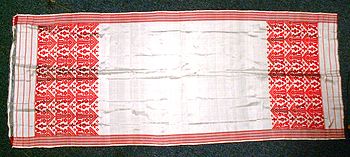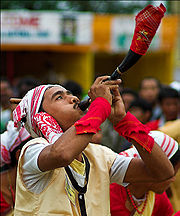
Gamosa
Encyclopedia

Assam
Assam , also, rarely, Assam Valley and formerly the Assam Province , is a northeastern state of India and is one of the most culturally and geographically distinct regions of the country...
.
It is generally a white rectangular piece of cloth with primarily a red border on three sides and red woven motifs on the fourth (in addition to red, other colors are also used). Although cotton
Cotton
Cotton is a soft, fluffy staple fiber that grows in a boll, or protective capsule, around the seeds of cotton plants of the genus Gossypium. The fiber is almost pure cellulose. The botanical purpose of cotton fiber is to aid in seed dispersal....
yarn is the most common material for making/weaving gamosas, there are special occiasion ones made from Pat silk.
Origin of the name
Literally translated, it means 'something to wipe the body with' (Ga=body, mosa=to wipe) however, interpreting the word gamosa as the body-wiping towel is misleading. The word gamosa is derived from the KamrupiKamrupi
Kamarupi or present Kamrupi is the language that was spoken in the Kamarupa kingdom in the first millennium, which, some linguists claim, gave rise to or influenced various eastern Indo-European languages like Assamese and Bengali.During British India at some point Kamrup was divided into two big...
word gaamasa (gaama+chadar), the cloth used to cover the Bhagavad
Bhagavad Gita
The ' , also more simply known as Gita, is a 700-verse Hindu scripture that is part of the ancient Sanskrit epic, the Mahabharata, but is frequently treated as a freestanding text, and in particular, as an Upanishad in its own right, one of the several books that constitute general Vedic tradition...
Purana at the altar.
Usage

- It is used to cover the altar at the prayer hall or cover the scriptures. An object of reverenceReverenceReverence may refer to:* Reverence a subjective response to something excellent in a personal way* Reverence , the acknowledgement of the legitimacy of the power of one's superior or superiors...
is never placed on the bare ground, but always on a gamosa. - It is used by the farmer as a waistcloth (tongali) or a loincloth (suriya); a Bihu danceBihu danceThe Bihu dance is a folk dance from the Indian state of Assam related to the festival of Bihu. This joyous dance is performed by both young men and women, and is characterized by brisk dance steps,and rapid hand movement...
r wraps it around the head with a fluffy knot (see picture). - It is hung around the neck at the prayer hall (naamghar) and was thrown over the shoulder in the past to signify social status.
- Guests are welcomed with the offering of a gamosa and tamul (betel nutBetel nutThe Areca nut is the seed of the Areca palm , which grows in much of the tropical Pacific, Asia, and parts of east Africa. It is commonly referred to as "betel nut" as it is often chewed wrapped in betel leaves.-Description:...
) and elders are offered gamosas (referred to as bihuwaan in this case) during BihuBihuBihu denotes a set of three different cultural festivals of Assam and celebrated by the Assamese diaspora around the world. Though they owe their origins to ancient rites and practices they have taken definite urban features and have become popular festivals in urban and commercialized milieus in...
.
One can therefore, very well say, that the gamosa symbolizes the life and culture of Assam.
Cultural significance
Significantly the gamosa is used equally by all irrespective of religious and ethnic backgrounds.At par with gamosa, there are beautifully woven symbolic clothes with attractive graphic designs being used by different cultural sub-systems and ethno-cultural groups as well.

There are efforts underway to have the Gamosa registered with the Geographical Indication
Geographical indication
A geographical indication is a name or sign used on certain products which corresponds to a specific geographical location or origin...
.

